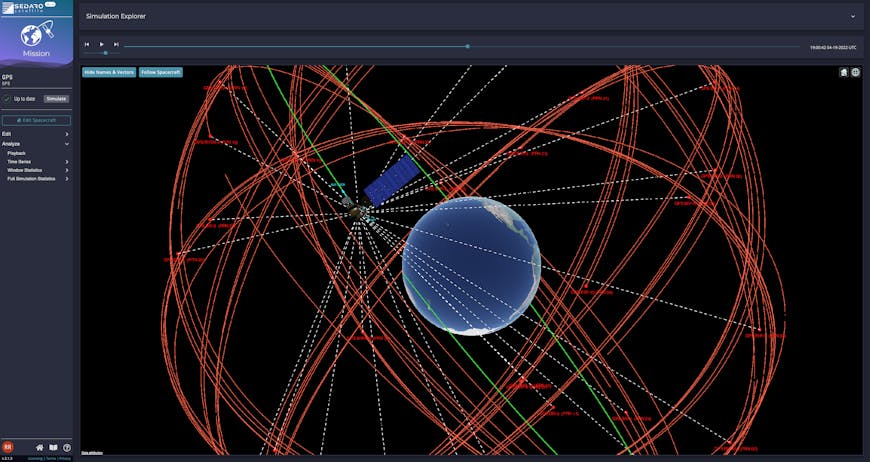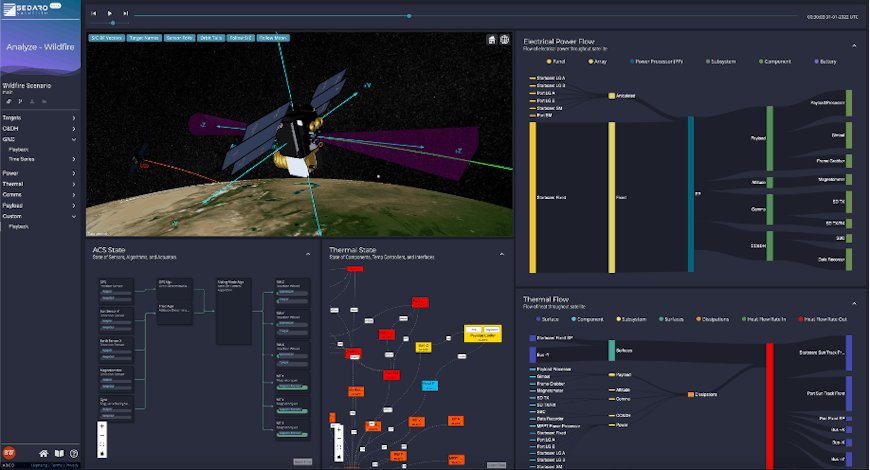Sedaro Satellite Visualizes Spacecraft Digital Twins in CesiumJS
Building, testing, and operating spacecraft is time intensive and expensive. Unexpected results can delay launch and on-orbit operations. To aid spacecraft design and limit the risk of costly design changes, Sedaro Satellite uses CesiumJS to visualize the outputs from its cloud-scalable digital twin simulations. Sedaro Satellite simulations are a powerful tool for collaborative design, testing, and operational decision-making.
Spacecraft digital twin power subsystem analytics in Sedaro’s web browser interface. The 3D view in CesiumJS shows this wildfire satellite imaging an active wildfire in the Yucatan Peninsula. Courtesy Sedaro.
Sedaro has been using CesiumJS since day one, streaming in data from Sedaro’s physics engines to visualize the flight paths of spacecraft.
If this sounds familiar, it’s because that’s how Cesium got its start.
CesiumJS enables Sedaro Satellite to present an accurate, time-dynamic virtual globe and customer spacecraft data in interactive web apps. Links to analytics boards can be shared with stakeholders and collaborators and accessed via browser on any device, displaying Cesium 3D playback alongside time-series charts and statistical performance metrics.

Power system simulation playback in Sedaro Satellite. CesiumJS visualization of the spacecraft, Earth, and Sun adds context to power generation by the spacecraft solar arrays. Courtesy Sedaro.
In fact, CesiumJS is what Sedaro showed government customers and end users in its earliest days, to get Small Business Innovation Research funding. The development effort for Sedaro Satellite kicked off in 2019. The prototype started with a Python physics engine built in three weeks and made use of CesiumJS as the main element of its 3D playback and analytics capabilities.
“What we get out of the box in open-source tools is amazing,” said Robbie Robertson, Sedaro CEO.

Cesium 3D view of a Sedaro Satellite scenario with digital twins of the entire GPS constellation. Courtesy Sedaro.
Sedaro Satellite enables engineers and technicians to build fewer physical prototypes and to integrate the distributed hardware, software, and human elements driving the engineering process. In just one spacecraft digital twin, each subsystem simulation connects and communicates with the others, mirroring the interfaces of the physical system. Spacecraft commands and software updates can be tested on the virtual model, and fixes to on-orbit faults can be approached in this same way prior to any changes deployed to the physical spacecraft. Not only does testing on a virtual model visualized in CesiumJS protect physical spacecraft, but it also creates realistic environments for training.

Custom playback interface in Sedaro Satellite's browser-based analytics. A remote sensing space vehicle is shown pointing to another digital twin in the simulation scenario: a lasercomm relay satellite. Attitude control, thermal, and power system dynamics for this vehicle demonstrate the interdisciplinary simulation made possible by Sedaro Satellite. Courtesy Sedaro.
Sedaro Satellite is Sedaro’s first product. In the near future, Sedaro will be leveraging its cloud-scalable system simulation technology to build similar products for UAVs, hypersonic vehicles, fixed-wing aircraft, and other vehicles. These domain-specific products will be interoperable, enabling users to build large multi-agent simulations that incorporate digital twins from multiple domains. A NASA or military mission, for example, might make use of both aircraft and spacecraft, and Sedaro will deliver the capability to create a simulation to concurrently assess the performance of both systems. Sedaro sees a future role in a metaverse-type environment used for engineering, as it delivers the engineering physics analog to gaming physics engines.

A digital twin of a radar satellite is shown pointing to a ground station in Alaska for downlink alongside live widgets indicating the flight software logic state and active operational mode of the satellite. Courtesy Sedaro.
There are two ways of delivering Sedaro Satellite: a multi-tenant SaaS solution, expected in the first quarter of 2023, and an enterprise solution for deploying a dedicated instance. The beta went live in August 2021, and 30 organizations are currently using the platform. Customers include the U.S. Space Force, NASA’s Jet Propulsion Laboratory, and a number of academic and commercial spacecraft developers.
Are you a developer working with CesiumJS? Check out our code examples, documentation, and tutorials.